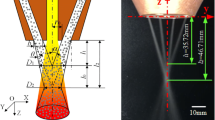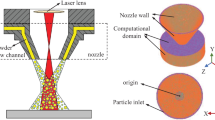Abstract
A new laser induction hybrid cladding technique on cylinder work piece is presented. Based on a series of laser induction hybrid experiments by off-axial powder feeding, the predicting models of individual clad geometric formation and powder catchment were developed in terms of powder feeding rate, laser special energy and induction energy density using multiple regression analysis. In addition, confirmation tests were performed to make a comparison between the predicting results and measured ones. Via the experiments and analysis, the conclusions can be lead to that the process parameters have crucial influence on the clad geometric formation and powder catchment, and that the predicting model reflects well the relationship between the clad geometric formation and process parameters in laser induction hybrid cladding.
Similar content being viewed by others
References
R. Villar, Laser cladding, SPIE, 5147 (2003) 385–392.
F. Bruckner, Lepski D and Beyer E, Finite element studies of stress evolution in induction assisted laser cladding, SPIE (2007) 63461D: 1–8.
Y. Zhang, Eliminating cladding cracks: pre-heating and stress analysis, ICALEO 2001; LMD:705–707.
G. S. Vasilash, Laser processing meets induction heating, Automotive Manufacturing & Production, 109 (1997) 54–55.
J. P. Davim, C. R. Oliveira and A. Cardoso, Predicting geometric form of clad in laser cladding by powder using multiple analysis regression (MRA), Materials & Design (2007) in press.
G. C. Onwubolu, J. P. Davim and C. R. Oliveira, Prediction of clad angle in laser cladding by powder using response surface methodology and scatter search, Optics & Laser Technology 39 (2007) 1130–1134.
J. Liu and L. Li, Study on cross-section clad profile in coaxial single-pass cladding with a low power laser, Optics & Laser Technology, 37 (2005) 478–482.
U. Oliveira, V. Ocelik and J. De Hosson, Analysis of coaxial laser cladding processing conditions, Surface & Coatings Technology, 197 (2005) 127–136.
J. Liu, Formation of cross-sectional profile of a clad bead in coaxial laser cladding, Optics & Laser Technology, 39 (2007) 532–1536.
J. Lin, A simple model of powder catchment in coaxial laser cladding, Optics & Laser Technology, 31 (1999) 233–238.
K. Zhang and W. Liu, Rearch on the processing experiments of laser metal deposition shaping, Optics & Laser Technology, 39 (2007) 549–557.
Author information
Authors and Affiliations
Corresponding author
Additional information
Recommended by Editor Sung-Lim Ko
Yongjun Huang received his B.S and M.S degrees in Material Engineering from Luoyang Institute of Technology in 1994 and Huazhong University of Science and Technology in 2001, respectively. In 2009 he received his Ph.D in Physical Electronics from Huazhong University of Science and Technology. He is currently an associate professor in the College of Engineering, Huazhong Agricultural University, Wuhan, China. His main research fields are laser processing and surface engineering.
Shengfa Yuan received his B.S and M.S. degrees in Farm Mechanical Engineering from Jiangxi Agricultural University in 1990 and Nanjing Agricultural University in 1993, respectively. In 2006, he received his Ph.D in Machine Design & Theory from Tsinghua University, Beijing. He is currently an associate professor in the College of Engineering, Huazhong Agricultural University, Wuhan, China. His main research interests are surface engineering and mechanical fault diagnosis.
Rights and permissions
About this article
Cite this article
Huang, Y., Yuan, S. Modeling the geometric formation and powder deposition mass in laser induction hybrid cladding. J Mech Sci Technol 26, 2347–2351 (2012). https://doi.org/10.1007/s12206-012-0612-3
Received:
Revised:
Accepted:
Published:
Issue Date:
DOI: https://doi.org/10.1007/s12206-012-0612-3




